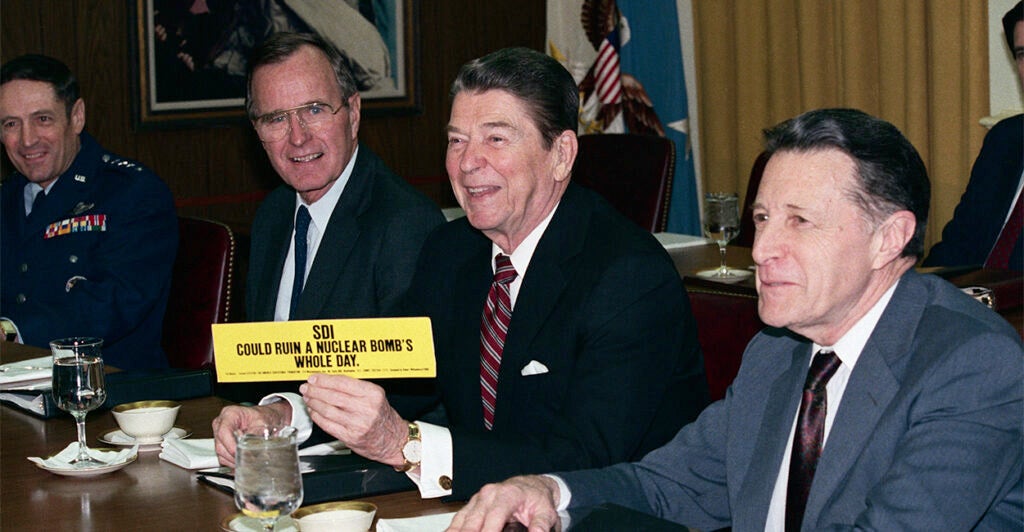Forty years ago Thursday, President Ronald Reagan addressed the American people to announce his plan for a national ballistic missile defense system. This new program, known as the Strategic Defense Initiative, or SDI, was envisioned to eventually protect the United States from any Soviet nuclear attack. However, years of force degradation and confusing policies from succeeding administrations leave the U.S. only barely able to defend itself from smaller nuclear powers, not the likes of Russia and China.
Traditional nuclear strategy during the Cold War adhered to the principles of deterrence and mutually assured destruction, also known appropriately as MAD, wherein the consequences of a nuclear attack by one nuclear power on another would lead to the total destruction of both.
MAD guided military doctrine for decades. However, amid a Soviet nuclear arms buildup in the 1970s and 1980s, Reagan became increasingly concerned about the inability to protect the country from a Soviet first strike.
It was in this context that SDI was conceived, with the goal of eliminating any strategic advantage the Soviets held by making their nuclear weapons obsolete.
The plan called for 1,000 ground-based missile interceptors and hundreds of interceptors based in space—a technologically difficult ambition, but if achieved, would provide a highly effective missile shield.
Reagan’s plan for a nation that did not have to fear foreign nuclear attack, while ambitious, was also hopeful. Unfortunately, little progress has been made toward achieving his goal today.
After Reagan’s two terms ended, several attempts were made to expand national missile defenses. Notably, the first Bush administration created the Global Protection Against Limited Strikes system, which would utilize a space-based interceptor system known as “Brilliant Pebbles” to defend against a nuclear attack of up to 200 warheads.
Brilliant Pebbles was later canceled by the Clinton administration, which, instead, pursued an even more limited defense system. President George W. Bush finally initiated the development of a limited defense of the homeland with the deployment of a handful of ground-based interceptors in Fort Greely, Alaska, and Vandenberg Space Force Base, California, by 2004.
As a result of these years of downsizing, today, this homeland defense system consists of a mere 44 ground-based interceptors. It has zero interceptors in space. That’s a far cry from the plan of over 1,000 interceptors on both land and in space envisioned by Reagan.
This limited capability leaves the U.S. only able to defend itself from smaller nuclear powers like North Korea. Indeed, a measly 44 interceptors could not defend against the Russian and Chinese arsenals of hundreds of missiles each.
A core issue behind this limited missile defense posture is that current U.S. policy dictates homeland missile defense should only address rogue states, like North Korea or Iran, while deterrence remains the primary strategy against near-peer adversaries like Russia and China.
Critics of homeland defense argue that creating a full defensive shield is escalatory and would spur a new nuclear arms race. As the argument goes, states like Russia would perceive the U.S. as no longer being bound by MAD and, thus, more likely to strike first without fear of reprisal.
Historical precedent, however, shows these fears are misplaced. The Soviets pursued a massive nuclear buildup during the Cold War, at a time when the U.S. had no active interceptors. Surely, actors with aggressive ambitions will expand their nuclear arsenals regardless of the American missile defense posture.
Indeed, 44 homeland missile interceptors could not be driving China’s current effort to build hundreds of new missiles. Likelier, China’s nuclear expansion is key to achieving its goal of supplanting the U.S. as the leading world power.
As such, the arguments against expanding missile defense do not stand up to scrutiny.
Instead, given the unprecedented nuclear threats facing the United States, particularly from Russia and China, but also North Korea and potentially Iran, we must reevaluate the role missile defense plays in U.S. national security.
The Pentagon currently has an effort underway to build a new, more capable missile interceptor for the homeland than the ones currently emplaced, called the Next Generation Interceptor. However, this interceptor won’t be ready for deployment until around 2028, and even then, only in small numbers.
Ideally, the Pentagon should devote more resources to expanding the missile defense program to ensure the U.S. can adequately respond to more than just extremely limited North Korean nuclear attacks.
The United States still has a long road ahead toward achieving Reagan’s vision of a country free from nuclear threat. In what is becoming an increasingly dangerous world, homeland missile defense once again needs to become a top priority.
Have an opinion about this article? To sound off, please email letters@DailySignal.com, and we’ll consider publishing your edited remarks in our regular “We Hear You” feature. Remember to include the URL or headline of the article plus your name and town and/or state.
